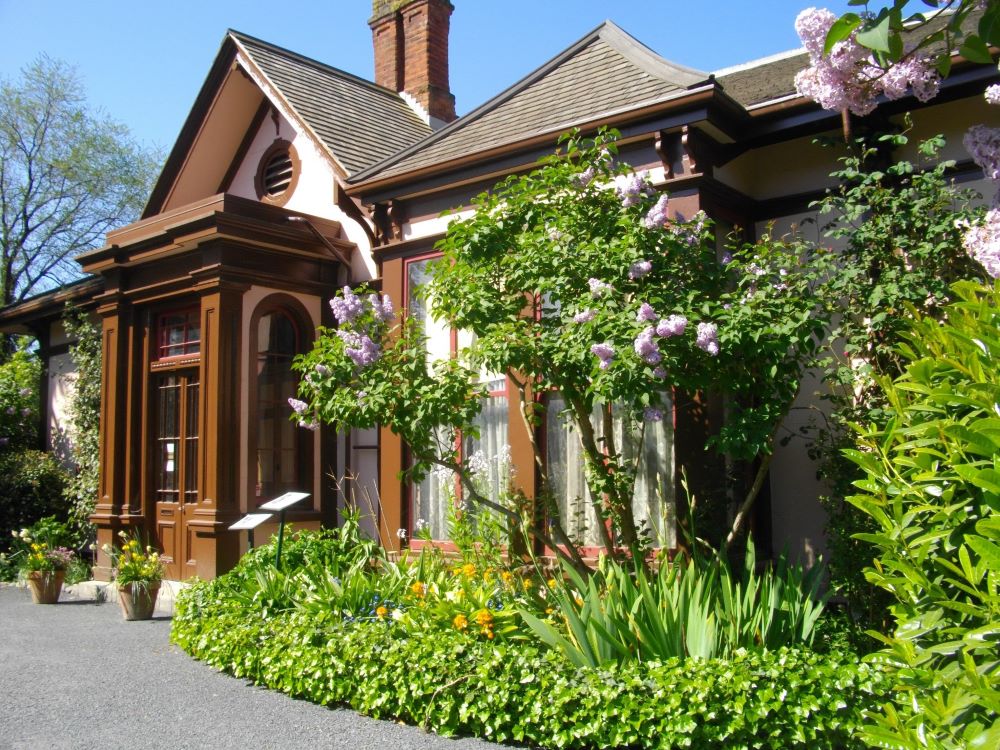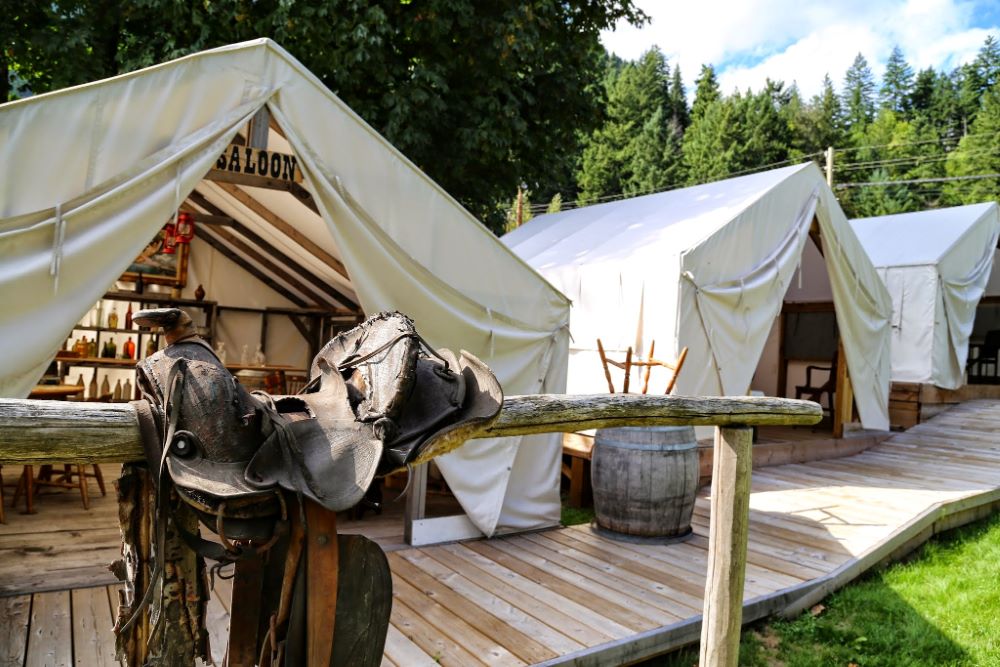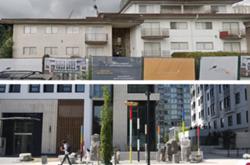With management changing at two B.C.-government-owned heritage sites, critics are saying insufficient funding and a lack of vision are strangling the sector.
But Premier David Eby and Lana Popham, the minister responsible for tourism, say that despite challenges operating the properties, they recognize the importance of the province’s heritage sites and are committed to supporting them.
Last month the Yale and District Historical Society announced that after more than 40 years it has lost the contract to manage the Yale Historic Site, which includes a museum with artifacts from the community’s past, a church built in 1863 that is one of the province’s oldest, and other properties.
“We’re very saddened and disheartened by this whole situation,” said Karen Rushlow, the society’s president. “Very sad to have this happen because we’ve been operating there for 46 years.”
The Yale Historic Site looks back to the gold rush, offering to transport you to the 19th century to “play a game of cards in the saloon, see the goods offered in the general store, and try your luck at gold panning.” The site also addresses the darker sides of the story, such as the treatment of Chinese railway workers.
The news followed the recent announcement that the Vancouver Island Local History Society which has managed Point Ellice House in the Rock Bay area of Victoria since 2019 is ending its contract a year early. Built in 1861 and 1862, the house is one of the oldest in Victoria and remained in the same family until 1975, when it and all the belongings were sold to the province.
For years it has been clear the province lacks a strategy for its heritage sites, said Kelly Black, the executive director and sole full-time staff member at Point Ellice House. “It’s an ad hoc policy that doesn’t really know where it’s going or what it’s trying to do.”
The priority for the government seems to be finding operators who are focused on raising revenue, Black said. “I get the sense from the heritage branch and the province they don’t care if you operate the museum or not, just don’t ask them for money.”
Eby responded to questions last Tuesday at an event where he announced $20 million for Science World in Vancouver and another $30 million for other tourism infrastructure that did not include provincially owned heritage sites.
“Of course there are always challenges for us and opportunities for us to do more and we’re going to keep doing that work,” Eby said. “Heritage sites are critically important to all British Columbians. They’re part of our shared history here in the province, and are a key tourism driver as well as a key opportunity for British Columbians to learn more about themselves and this amazing place where we live.”
The province owns at least a dozen heritage properties. Among them are the towns of Barkerville and Fort Steele; the Grist Mill at Keremeos; Hat Creek Ranch; the Kilby Store and Farm near the confluence of the Fraser and Harrison rivers; Craigflower Schoolhouse, Craigflower Manor and Emily Carr House in Victoria; and Cottonwood House on the old Cariboo Wagon Road.

They were acquired over many years by various governments, in at least some cases for a nominal fee. They are managed through the heritage branch, which after several years in the Forests Ministry was recently moved into tourism, arts, culture and sport.
Management of the sites took a significant turn after the 2001 election when the then-BC Liberal government’s “core review” concluded that heritage sites weren’t part of the government’s core business and proceeded to contract out their operation to small groups, a structure that has left many of them short of funding and without the stability for long-term planning.
In the case of the Yale Historic Site, it was maintained by a committed local group. According to the Yale and District Historical Society, the site was created by people in the community before it was sold decades ago for $1 to the provincial government “with a good faith agreement that YDHS would continue to manage it.”
The society operated the site for decades before receiving notice from the province’s heritage branch last year that it would have to compete in a request for proposals process if it wanted to keep its role.
“The application process was based on a scoring system that was weighted most heavily on experience, and so — having managed the site for 40 years, and owning 95 per cent of the museum’s artifacts and historical information displays — YDHS felt it was in a strong position,” a statement from the society said.
The application had been reviewed by a heritage professional who thought it was strong and it included letters of support from the Yale First Nation, Fraser Valley Regional District and Tourism Hope.
The RFP process ended with the heritage branch awarding the contract to another applicant, Forager Foundation, and negotiating with the historical society on a transition that includes a request it sell or lease its collection of artifacts.
The society says it has complained to a tourism assistant deputy minister about how the tendering process was administered and its outcome, and it has started a petition to keep management of the site local.
The founder of the Forager Foundation, Bryce Watts, said he understands that the change is hard for the people who have been running the site for so long, but that he hopes people in Yale will feel reassured when they meet him and others on the team.
“I’m hopeful when I arrive it will show people we’re just people who are passionate about heritage like them,” Watts said, adding that the local group has put in place a good legacy to build from.
Forager Foundation’s contract to manage the site started May 1, he said, but various conversations have to happen before the transition can be made. He’s planning a community event for later in May to introduce Forager Foundation and hopes to meet with local First Nations soon about working together to tell a broader story at the site.
Watts said he’s aware of complaints in the sector of underfunding, but Forager Foundation has plans to seek “out of the box” sources of revenue, such as from grants, school field trips or paid tours.
And while Forager Foundation has never directly run a heritage site before, he said, it has put well-received programs and resources together for other sites in the province and made clear in its proposal it has the expertise needed to do a good job.
“We were quite happy with what we put together,” said Watts, adding he’s excited for the opportunity. “I think it’s a great story to be told.”
Popham said in an interview the YDHS was given ample notice that the RFP process would happen in 2023 and they had plenty of time to prepare.
“The process happened and they were not the successful proponents,” Popham said, adding it’s understandable the group is disappointed given how long they held the contract.
“The process was fair,” she said. “The new operator brought things to the table that had not been in place previously. An example would be a very strong cultural engagement plan, which includes of course Indigenous stories, but also the Chinese community. That story hadn’t necessarily been told.”
Rushlow with the YDHS said the museum’s displays and exhibits did include the stories of Chinese settlers and that there was a room dedicated to Chinese artifacts. A plan to rebuild the On Lee home had been stymied due to a lack of provincial government funding, she said.
Margaret Stubson, the operations manager for the society, said it is difficult to raise money from donations in a tiny community like Yale and that the heritage branch opposed proposals that would have made the site more financially sustainable.
“I can tell you we’re severely underfunded and unfortunately every time one of the management team has thoughts of creating something that would make money we are absolutely hammered down,” Stubson said. “Anything to improve the income of this site has been stalled or outright rejected. We just can’t move forward.”
There may be more change coming for other heritage sites in the province soon.
In 2021, following a consultation process, the Heritage Branch committed to “engage Indigenous partners, other stake-holders, and the public to revise and develop Heritage Branch policies in a manner that incorporates diverse perspectives.”
The provincial heritage properties in particular were identified as places “where Indigenous Peoples were generally not involved regardless of their connection to the land where the sites are located” and past operating practices failed to recognize the unique perspectives of Indigenous Peoples.
The report promised greater collaboration and recognition of Indigenous history and culture and said the branch had “begun conversations with some Indigenous partners on the cooperative management of several of its sites.”
The sites are managed under five-year contracts, a model the current government inherited, and many of them are coming up for renewal soon, Popham said.
In the case of Point Ellice House, it was a disappointment that Black couldn’t be convinced to complete the contract, she said.
There is some disagreement about how much money was on offer. According to Black, the contract to manage Point Ellice House was worth $80,000 a year and the ministry was willing to increase it by $30,000. Popham says the offered increase was $50,000.
Black said the total offered was far short of the $325,000 that he had told Popham and other local MLAs would be necessary to make the site sustainable and keep its doors open. Already the house was only open eight hours a week, split between Saturday and Sunday, from February to December.
The operators gave the government 60-days notice and will be finished around the May long weekend.
“It was disappointing,” Popham said of Black’s decision to leave. “It brings some negativity to sites that already really struggle. The heritage sites are trying to attract folks in, and from a tourism perspective we want them to be a strong network around the province, attracting our own British Columbians but also people from outside B.C.”
The government provides operating funding to the sites every year, as well as money for unexpected expenses, but it’s true that when requests for proposals go out the ministry is looking for strong business plans that include ideas for generating income, Popham said.
“I think there’s a lot of potential to be able to share really good stories and have strong messages coming from our heritage sites and that includes bringing people in to hear them,” she said. Attendance and financial stability go together, she said.
“We believe strongly in our heritage, but we want to be able to share it with people.”
She acknowledged that she had suggested making Point Ellice House more available for weddings or other events, an idea Black dismissed given how short-staffed the site already is.
Hosting events is an immense amount of work that requires staff, Black said, adding that he figured it would take about 120 weddings a year to make up the budget shortfall. “These kinds of comments are really detached from the reality of what it takes to operate these sites and what is different and unique about each of the sites.”
Without enough core funding, it was impossible to grow, he said. “One person cannot run a provincial heritage site, and more to the point, one person would not be able to bring in the revenue through donations, admissions and events that’s possible when you have paid staff.”
The government’s preoccupation with making the sites more self-supporting limits the role they can play and takes them away from what they need to be doing, Black said.
“There really is this philosophical question about what is the point of a museum and heritage site in a community and I’m not sure the heritage branch and the provincial government have made any effort to engage with that question.” ![]()
Read more: BC Politics, Urban Planning

















Tyee Commenting Guidelines
Comments that violate guidelines risk being deleted, and violations may result in a temporary or permanent user ban. Maintain the spirit of good conversation to stay in the discussion and be patient with moderators. Comments are reviewed regularly but not in real time.
Do:
Do not: